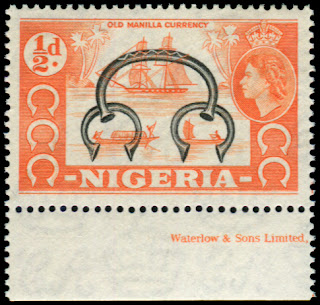The 1961-1965 "Independence" Definitive Issue

I have been looking at the viewership statistics for the one post that I did on the 1962-63 commemoratives with some dismay. It seems that most of you are not that interested in the post-independence issues. Maybe I'm mistaken. It is indeed a pity if I am, as the post-independence period has so much to offer, as I hope the next few posts will show. Indeed, Nigeria is one of the few countries, now in the whole world, where the number of basic issued stamps is still under 1000 basic catalogue numbers. My country, Canada, which has a very reasonable new issue policy has issued over 2,400 stamps. Nigeria, in contrast had, up to 2008 still issued fewer than 900 stamps. In addition, it is one of the few countries whose stamps illustrate subject matter that is relevant to the country and its people. On January 1, 1961, just 3 months after the country declared its independence, a new definitive set appeared to replace the previous pictorial issue. Gone are the images of Queen Elizabeth I

